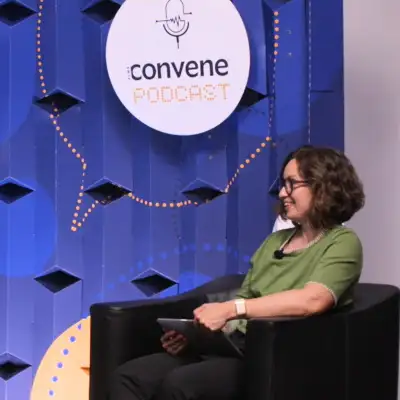Creators and Guests
What is PCMA Convene Podcast?
Since 1986, Convene has been delivering award-winning content that helps event professionals plan and execute innovative and successful events. Join the Convene editors as we dive into the latest topics of interest to — and some flying under the radar of — the business events community.
Convene Talk, ep. 86/November 7, 2025
*Note: the transcript is AI generated, excuse typos and inaccuracies
Magdalina Atanassova: This is the Convene Podcast. Welcome to another Convene talk. Kate, it's all yours.
Kate Mulcrone: Thanks, Maggie. Today we're going to talk about something that I think we'll all have a pretty strong opinion about,
and that is whether we still need swag at business events.
And if we think, yes, we do,
then maybe we want to put some guidelines around it. And the reason I brought this topic to us today is because of a story I saw in Skift last week that I also saw in their newsletter again today.
Seven wellness themed gifting ideas.
And I see a story like this with lots of very helpful suggestions for more meaningful swag and as a step in the right direction.
Yes,
it's recognizing that you want to give someone something,
that the impact that it makes is worth the money you're spending,
but also increasingly creating waste,
adding to the footprint of your event.
But then it also really brings up my own feeling, and I don't expect everyone to agree with me that the best swag is nothing at all.
I would be very happy to go to a business event and leave with only my memories and the pictures I took on my phone and the relationships I made.
And I don't necessarily think everyone is on the same page with me.
When I was on a recent press trip with a group of planners,
we were given a lot of swag every stop of the tour. And there were a lot.
And it was very interesting to see how the group of about 10 people really did break down into me and one other planner who didn't want anything.
And then on the other end were people who, they did want the swag,
but. But the truth is they were planning to give it away to, like, their children or grandchildren,
which does raise the question,
is there a true business purpose to this? And so now I want to open it up to the group. And Michelle, what do you think?
Michelle Russell: Thanks, Kate. You know, the best experience I had in the kind of no swag category is I don't know if it was a press trip, but it was a trip, an industry event in Toronto.
And they gave us, instead of swag, they gave us a certain amount of money as a group, like we were. They just grouped us into small groups and they gave us, say, $250 that they probably would have spent on some, you know,
destination themed swag.
And they said,
here are four charities.
You guys sit together and decide how you can give some to one charity. You can give all to one charity, but have a conversation about the ones that are most meaningful to you.
And I love that because we kind of got to understand what our values were and what we really cared about.
And also I felt like we were helping to contribute to something that wasn't leaving a footprint, but actually helping in terms of the destination that we. The host destination.
So I love that idea. I also wasn't sure what swag meant until I looked it up, and I think, does everybody know what it stands for on this call?
No.
I say stuff we all get, but it's actually not stuff, but another word similar to that.
And I think Maggie's story that she wrote a few.
Maybe a few years ago now, the one that really stuck out to me was when someone had their mother make something,
and it was a handmade item that everybody received.
And as somebody who does crafts, I thought that was just not only memorable, but meaningful and not contributing to, you know,
the footprint.
It's not something plastic or something that you're gonna end up recycling,
but it will have meaning, and it will definitely connect you to that event because it's human. It's made by human beings,
and it has a story behind it.
So, Barbara, what are you thinking?
Barbara Palmer: You know,
I am reminded of Sonali Diddy.
She's an associate professor in design and merchandising at Colorado State University, and she also teaches at the University School of Global Environmental Sustainability,
and she's an expert on textile waste.
And the reason I bring her up is that she put on a conference at csu,
and it was really,
you know, it was a real issue for her about swag because she understood that it was expected.
The thing that is underneath swag,
in my opinion, and I think also according to research,
is connection.
I feel like it's just everywhere. Like, you exchange something and you feel connected,
and the question is, what is it that you're exchanging and what meaning does it have?
I wrote a story about a Treedom,
which is a. It's a company that plants trees that contribute not just to taking carbon out of the air,
but to farmers, livelihoods all over, like Kenya, Indonesia,
other countries in Africa.
And they sent me a little tree,
and I get updates on what that tree does, like, what impact it has.
And it's something that I've started giving to my family in the same little grove where my tree is, so that we all have, like, these trees that are grow. And I feel like those kinds of things have real meaning.
And it takes more thought to, like, connect what you're giving to the event.
Just one more example is I recently went to Destination Canada,
had an incentive trip that I Attended which everything was extremely luxurious as incentive trips are.
And the swag was so thoughtful and so consumable.
It was as like they have a goal of net zero.
One night we went to a lavender farm and when we got back to my hotel room they had left a little glass dome with a bed of lavender and there were some cookies on it.
And it was just such a visceral connection to the evening.
I feel like this,
I guess all of this is just to say connection is what people are striving for and there are ways to do it that don't result in a lot of excess plastic.
Jen, I'm eager to hear what you have to say.
Jennifer N. Dienst: I just wanted to say I love those two points that you made. Like one, that it needs to be thoughtful and two, that it needs to be consumable.
And to me that's like you could physically eat it or drink it,
but also that you're actually going to consume it and use it in some way. I think that's when it, you know, when it's, when it's not checking those boxes and that's when it becomes waste.
And not only a waste of the person who's buying its money or the company that's buying its money, but a waste of,
you know, it's creating more landfill waste. So I love the idea of or some of the examples that you gave.
And I have to say that on some of my most recent press trips I have noticed definitely a not a lot more thoughtfulness. Like the past two press trips, maybe three.
In lieu of just getting stuff, they've given us gift cards to local stores or you know, wherever we are going to be, they give us a gift card that we can use to buy something that we, we want or like, which I first, it's fun.
It just makes for like a fun little shopping experience to monies actually going back to these local stores, local makers, whoever it is,
and you can get a gift for yourself, you can get a gift for a family member, whatever. I think that just makes way more sense.
I don't love the pens and I don't love the stuff that I don't need.
But I am quite happy when I get something on a, especially on a press trip that's food related,
food or drink related because I know I'm gonna come back at some point and wanna snack. I know that's hard with allergies and you know, dietary restrictions and all that.
But I, I will say that those are, those are some of the things I think are worth the extra effort and. And the. And the money spent, if. If you're gonna do it.
I feel like those two examples really do make it so that it's. It's worthwhile.
But.
But, yeah, I think we're getting better at it. I feel like,
you know, I don't know if anyone remembers that episode of the Office where he.
Everyone goes to the trade show and Michael's running around in all his swag. Like, his.
He's got like a Microsoft T shirt on, and it's hysterical. But I kind of. I don't know that, you know, people are doing that as much now. I mean, maybe in some trade shows or some events, but I don't think it's as pervasive as it once was.
Barbara, what are you thinking?
Barbara Palmer: You just makes me laugh when you say we're getting better. Because I do remember just really thinking, what can I do with this?
And I think because it's an attempt to make a connection,
it feels hard to refuse it with, you know, and sometimes it just.
So I guess I was just thinking about, like,
just being in hotel rooms and just feeling very overwhelmed and kind of guilty about, like,
what all this stuff.
So I am so happy that there's been a change, I think, in consciousness about it now. Maggie,
I'd love to hear what you have to say.
Magdalina Atanassova: It's funny, Jen, that you gave that example with the Office, because that was exactly the first thought I had when I.
About the topic that Kate picked.
I was like,
yeah, I remember my very first time at IMEX as a student, and I had this huge bag and just collecting stuff from every stand, and I was trying to live with all that.
And it was super heavy by the end of the day.
And, you know,
so many years later, now I'm like, please don't give me anything. I travel light. I travel with a carry icon. I have no space of putting anything.
And I've even received gifts, like big bottle of olive oil. Who can travel with that? What if it breaks? Like, don't.
No, just. The answer is no.
Keep it. Like, give it to somebody else or donate it locally.
But also, Michelle, that example that you gave on the story, it was from an IAPCO event in Vancouver. And it was really my best event in terms of swag. I mean, it was best event in many.
In, you know, many experiences. But for the swag, it really stands out not only because of the story of the president back then,
who, you know, his mother made all these slippers for everyone, handmade from their own sheep. You know, it Was like such a,
there was a, such a big story and it had a video of how she was making them by hand. It was amazing. It was wonderful. I wanted to have these slippers forever.
So was definitely very memorable. But also they aim for zero waste. So they had some sponsored items lined up for everyone to pick and they said whatever is not being selected is going to be donated.
So if you like to have another water bottle, please do take it.
But also be calm that if you don't select anything, that's fine, it's going to go to local shelters or schools or whatever, you know,
organization may need it.
So that really stood out back then to me. It was five years ago. And yeah, we definitely are making strides in terms of swag and what people are bringing at trade shows and how they're engaging and they're trying to be a bit more thinking of the experience rather than shoving some plastic stuff in your hands and pens and bottles,
which I don't know if it's still like that,
but back then the first day you couldn't get anything. And on day three at IMEX, everyone was just giving you like 50 items because they didn't want to travel back with them.
And one thing that also I had a thought of was, Barbara, your story about the tree, which is amazing. But what kept on coming back to my mind was those pencils with seeds in them that apparently after you use the pencil, you can just plant it, put it in,
you know, a pot and a flower would grow.
I don't know about you if you've gotten such a gift, but I've never had flowers grow, not in those seeds.
So I was never successful either. I'm a very bad person at this.
Barbara Palmer: I don't know, Baro,
I was hanging on your words because I was like,
did they grow?
Because I have not, I have not succeeded. And no flowers have ever come up when I've planted those.
So I kind of ignore them now. Like, I like, oh, that's, that's a nice idea.
That's a nice idea.
I started to talk about the swag that made me laugh and I didn't want to be insulting, but I once got a pillowcase with, with a picture of a convention center on it and I just thought, well,
well,
this is, this is not really.
I don't think I'll be putting that on my pillow.
I mean, it was a, it was usable.
But anyway, I do, I do like thought that goes into swag.
Magdalina Atanassova: Also with the socks. I mean, sometimes they're nice, but sometimes it's like just the design or. Or the material. There are, like, so many questions. You need to put some thought into that.
Like with that pillowcase. I mean, I wonder what was going on through the mind of that marketing person who suggested it and the person that approved it. After all,
I was like, what were they thinking?
Jennifer N. Dienst: Yeah.
Barbara Palmer: And just talking about IMEX, I still have a.
I think it was. I think Singapore had some cloth bags that were beautiful print and I use it for groceries.
You know, it's just beautiful.
Kate Mulcrone: I also still have one of those bags. I know the exact one you're talking about. I got it at Imax more than 10 years ago and I use it to hold all of my embroidery supplies.
Magdalina Atanassova: Perfect.
Jennifer N. Dienst: Is it.
Barbara Palmer: Was it Malaysia that.
Kate Mulcrone: I think it was Malaysia in the other room. I could check, but I do think it was Malaysia.
Michelle Russell: Yeah.
Kate Mulcrone: And mine is purple. What is yours look like?
Barbara Palmer: Mine is like, it's. It's. The background is brown, but it has beautiful flowers on it.
Kate Mulcrone: Yeah, mine is flowered as well.
Barbara Palmer: Yeah.
Magdalina Atanassova: You know, a cool thing I still keep from IMEX, which I think also connects nicely to the experience,
is I got a perfume from a hotel chain in Asia and that's the perfume that they spray their rooms with.
It's very nice. It's really very nice. And it's very elegant. It's super cool. And I still, I still have it and I still use it so I can make my whole house smell like a very fancy hotel.
Barbara Palmer: And you think of that hotel, right? You think, you think of being there every. Because I think I know that smell is the most immediate sense. Like when you smell something, it's like directly to your brain.
A hotel in Cape Town gave me that spray and I loved that experience of being there so much.
So I know exactly what you're talking about,
how that really takes you into the experience,
which I think is definitely what they're trying to do.
You know, that connection is really made very sturdily.
Magdalina Atanassova: And there will be a lot of links in the show notes this time because we've referred to a lot of good articles worth rereading if you've read them before.
Thanks, Kate, for picking the topic and everyone for the conversation.
Remember to subscribe to the Convene Podcast on your favorite listening platform to stay updated with our latest episodes. For further industry insights from the Convene team, head over to PCMA.org/convene. My name is Maggie. Stay inspired. Keep inspiring. And until next time.




